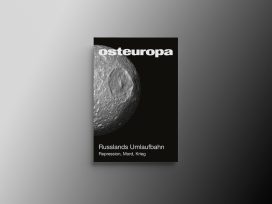Vertical occupation
Perceiving war as a series of strategic manoeuvres delineated on a map renders a horizontal view of conflict. And projecting an end to fighting is fundamentally restorative. But deep pollution, as is occurring in Ukraine from Russia’s radioactive colonialism, warns of a more persistent dimension with long-term environmental impact.
Wars have many beginnings, but they refuse to end — history is merciless in giving this lesson to us again and again. Amid the ten-year Russian war in Ukraine, this thought is unbearable. Despite all odds, we need the idea of victory to hold us together in a shared effort of moving through the horrid reality of loss and devastation that ruptures and obliterates our more-than-human communities, land and material culture. The idea of victory is an orienting force in the chaos of war, it serves as a guarantee of the future where Ukrainian society is not stripped of dignity and recovery is possible.
At the same time, a nuanced study of wars’ aftermaths demonstrates that the notion of clear-cut victory belongs to the past. Wars proliferate by forming martial regimes prior to and after the wars’ formal beginnings and ends when occupation forces continue to deny their presence on the territory of another state or when the pervasive military surveillance remains ongoing after military conflicts are over. Within recent decades, we have become better equipped to recognize the hidden modes of wars settling in everyday life. Most of them, however, are too subtle or too slow to grasp amid the loud and bloody all-out war, but they target, without our awareness, the most delicate and most intimate life-affirming connections — within us and between us.
My goal is to develop conceptual tools for recognizing the forms, vectors, temporalities and dynamics of these subtle-yet-deadly hazards — to shake our imagination for envisioning, together, the infrastructures of care and co-existence, within our hopefully remediated landscapes or whatever remains of them.
In official and public discourse, the victory of Ukraine and the end of the Russian war is associated with a full restoration of the Ukrainian territories of 1991 as a core condition (a deranged Russian ex-president has recently threatened that this would be followed by a nuclear war). Such restoration of territories, our citizens believe, should be accompanied by the return of the deported children, Ukrainian prisoners of war and civilians, then, a grand reparation, followed with an international tribunal, the latter to close the gap between the political and legal understandings of genocide and crimes against humanity in Ukraine.
In how it is envisioned, de-occupation has an explicit horizontal dimension: Ukrainian citizens imagine the end of this war horizontally, despite this war’s multidimensional character. Simplified views can help, and so, for the purposes of understanding the basic dynamics of the fighting, the complexity of the battlefield is often flattened to a two-dimensional map, as would be drawn from a martial point of view — we look at it from above to see how the frontline moves. But critical thought warns us, always, to be cautious about the gamer’s view through which most of the war bloggers explain to us the strategic and tactical moves — or their absence — on the flattened battlefield.
Environmental zero-day exploits
The voluminous battlefield does not reveal itself easily to a remote observer. Considering the environmental impact of war may help us to move beyond horizontality. In Ukraine, smaller and larger environmental organizations and centres have done a lot to assess and report the environmental impacts of the war since they became impossible to ignore years prior to the full-scale invasion. The scope of this devastating impact is not for a short essay, so let us focus on one narrow theme to lead us to the notion of vertical occupation, which is crucial for understanding the complex and entangled temporality and spatiality of this war.
Soon after the beginning of the Russian war in Ukraine in 2014, when the Russian military infiltrated the coal-rich Donbas to incite military action, environmentalists reported the danger posed by abandoned and neglected coal mines: they had been persistently filling up with toxic groundwater for fifty years. The situation had become critical even without military action. The reports pointed out the core of the problem: when water pumping from the mines is stopped, the level eventually rises too high, whereupon it will spill heavy metals and other pollutants into surrounding rivers, lakes and wells, leading to the contamination of drinking water and poisoning of the soil, making land unfit for farming.
Among the most illustrative examples is one of the 220 coal mines in the Donetsk Coal Basin, the Yunkom mine, named after a small mining town Yunokomunarivsk, now Bunhe, located forty-three kilometres north-east of Donetsk. The slow flooding of the mine due to the shutting off of the mine’s pumps by the occupation government of the so-called Donetsk People’s Republic in spring 2018 drew attention to the mine’s dark history. In 1979, an industrial underground nuclear explosion was performed at a depth of 903 metres with a TNT equivalent yield of 200 to 300 tonnes, approximately 2% of the explosive yield of the Hiroshima bomb. This 530th nuclear explosion on the territory of the USSR took place right under Yunokomunarivsk, and the town’s 22,000 dwellers were, unsurprisingly, misinformed about the nature of the explosion. The officials then presented it as a necessary civil defence exercise. In Soviet nuclear history, this site became known as Object Klivazh, but after the Chornobyl catastrophe rocked and shattered the Soviet version of history, it was renamed in popular discourse as ‘Donetsk Chornobyl’. Forty-five years later, it is still hard to assess the damage and remaining risk because the composition of the nuclear device from Moscow was undisclosed and is still buried in classified archives. Therefore, the current potency of radioactive matter sitting under the top layer of soil and coal deposit remains unclear. The living memory of the massive death of workers who were sent back into the mines after the nuclear detonation is among the few reliable warnings surviving today. We are the media and the archive.

Zaporizhzhia and Kakhovka Reservoir (crop), July 2023. Image by Enno Lenze via Wikimedia Commons
Even outside military contexts, mines are hazardous for the environment because they pollute the local atmosphere with solid and gaseous substances used in the mining industry, and cause the disturbance of the earth’s surface, and ground and surface waters. In a military setting, they are a weapon, and they are a weapon with a history. During these two years of war, we have already seen multiple times how the sites of past environmental disasters — often the consequence of the Soviet regime’s criminal negligence, made systemic by their straightforward imperial, exploitative mindset — are used as environmental zero-day exploits.
The Kakhovka Reservoir was one of the biggest of such time-bombs. The projected aftermath of the Kakhovka Dam’s destruction is, according to some accounts, Ukraine’s ‘worst ecological disaster since Chornobyl’. Too often, Russian war on life comes down to being nuclear. In their 1986 essay ‘Native America: The Political Economy of Radioactive Colonialism’, Native American economist and environmentalist Winona LaDuke and American writer and activist Ward Churchill claim that ‘colonialism has a radioactive quality’: ‘it cannot be undone’; they insist it continues to destroy, turning on ‘everyone alive and everyone who will be alive’. The notion ‘radioactive colonialism’ thus captures the long-lasting impacts of two hazards that mutually reinforce their already-deadly damage on both molecular and planetary levels: one is radioactive pollution and the second is colonialism.
The wars of the twentieth and twenty-first centuries are all ‘ecologized’ wars, as German philosopher Peter Sloterdijk reminds us. Almost paradoxically in the age of precision weapons, such wars, like the Russian war on Ukraine, target broader environments on a micro and macro-scale, which makes ‘collateral damage’ — or everyone and everything that falls dead or damaged by war — not an exception, but the core rule of warfare. These late modern wars are always fought environmentally. Often, the material composition of such environments, from debris and pollution to air sirens and explosions, from masterminded PSYOPs to random informational chaos, is employed to produce terror that suppresses the subject of war from within — just like it makes the living body hostage by the necessity of breathing poisoned air or drinking poisoned water. The Russian war on Ukraine is an example of such modern environmental warfare, but it also unfolds in a particular terror environment on the nexus of cyber and nuclear. This war is defined and saturated by nuclear terror that is constantly amplified and disseminated by cyber warfare operations.
Lingering ecological repercussions
When in 2018, the radioactive material in underground waters threatened to surface by crawling up vertical shafts of the abandoned industrial mines, the repressed knowledge of the ‘Donetsk Chornobyl’ came back to us. It was with both pain and awe that I thought back then of how history can only be produced in the mode of future in the past. When you look at the flow of dispersed events from the point of the ‘original accident’, as French philosopher Paul Virilio provocatively and provisionally named the Chornobyl catastrophe, the history as you knew it changes. There is nothing accidental, of course, about such accidents for Virilio. Instead, the term expresses the philosopher’s dark irony towards our blindness and unwillingness to confront the systemic nature of catastrophes in modernity (with imperialism being a primary example), rather than celebrating modernity’s delusionary progress.
By now it is clear, I hope, that this war is the original accident of the history of the Cold War, that opens a dreadful view of the future, against which we must brace ourselves. Amid Ukraine’s wounded fields and the ashes of urban landscapes, when more than 174,000 square kilometres of the country is contaminated with mines and unexploded ordnance planted in our soil, this future, growing in the horrid present and in close proximity to the imperial past, reveals the dimension of the current occupation that postpones the end of the war to the point of never. This dimension is vertical — it persists as deadly radiance under our feet.
The original version of this article was published in London Ukrainian Review in its first issue on the theme of ‘War on the environment’.
Published 15 April 2024
Original in English
First published by London Ukrainian Review (4 March 2024)
Contributed by Institute for Human Sciences (IWM) © Svitlana Matviyenko / London Ukrainan Review / Institute for Human Sciences (IWM) / Eurozine
PDF/PRINTIn collaboration with
In focal points
Newsletter
Subscribe to know what’s worth thinking about.
Related Articles

Tracing responsibility for honeybee losses in rural Ukraine points to farmers and pesticide-treated rapeseed fields. But whose practices really lie behind the short-term bid to increase crop productivity? And what do the historic uses of agrochemicals tell us about their current weaponization?

The visions of an apocalypse peddled by nihilistic humanists and misanthropic transhumanists confuse the destruction of humankind with salvation.






